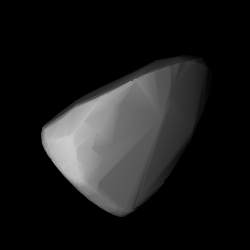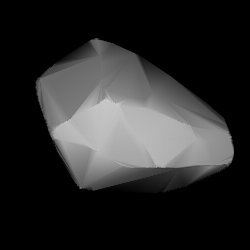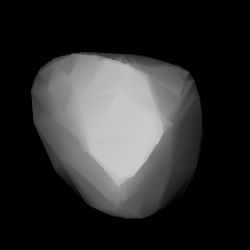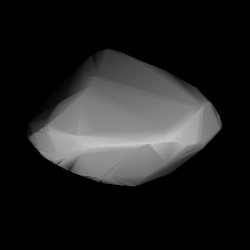Related Research Articles
Arago, provisional designation 1923 OT, is a dark asteroid from the outer regions of the asteroid belt, approximately 55 kilometers in diameter. It was discovered on 5 September 1923, by Russian astronomer Sergey Belyavsky at the Simeiz Observatory on the Crimean peninsula. The asteroid was named after French mathematician François Arago.
1062 Ljuba, provisional designation 1925 TD, is a carbonaceous background asteroid from the outer regions of the asteroid belt, approximately 58 kilometers in diameter. The asteroid was discovered on 11 October 1925, by Soviet–Russian astronomer Sergey Belyavsky at the Simeiz Observatory on the Crimean peninsula. It was named after female paratrooper Ljuba Berlin, who died at an early age. The C-type asteroid has a longer-than average rotation period of 33.8 hours.
1084 Tamariwa, provisional designation 1926 CC, is a carbonaceous background asteroid approximately 27 kilometres in diameter from the central regions of the asteroid belt. It was discovered on 12 February 1926, by Soviet astronomer Sergey Belyavsky at the Simeiz Observatory on the Crimean peninsula. The asteroid was named after female paratrooper Tamara Ivanova, who died at an early age.

1554 Yugoslavia, provisional designation 1940 RE, is a stony Eunomian asteroid from the middle region of the asteroid belt, approximately 16 kilometres (9.9 mi) in diameter. It was discovered by Serbian astronomer Milorad Protić at Belgrade Astronomical Observatory, Serbia, on 6 September 1940. It was named for the former country of Yugoslavia.

1110 Jaroslawa is a bright background asteroid and rather slow rotator from the inner regions of the asteroid belt. The stony S-type asteroid has a rotation period of 97.4 hours and measures approximately 13 kilometers in diameter. It was discovered at the Simeiz Observatory on the Crimean peninsula on 10 August 1928, by astronomer Soviet Grigory Neujmin, who named it after his son, Jaroslav Grigorevich Neujmin.
1123 Shapleya, provisional designation 1928 ST, is a stony Florian asteroid from the inner regions of the asteroid belt, approximately 11 kilometers in diameter. It was discovered on 21 September 1928, by Russian astronomer Grigory Neujmin at Simeiz Observatory on the Crimean peninsula. It was named after American astronomer Harlow Shapley.

1129 Neujmina is an Eos asteroid from the outer regions of the asteroid belt. It was discovered on 8 August 1929, by astronomer Praskoviya Parchomenko at the Simeiz Observatory on the Crimean peninsula. The stony S-type asteroid has a rotation period of 5.1 hours and measures approximately 34 kilometers in diameter. It was named after Soviet astronomer Grigory Neujmin.

1137 Raïssa is a stony background asteroid and slow rotator, approximately 22 kilometers in diameter, located in the inner regions of the asteroid belt. It was discovered by Grigory Neujmin at Simeiz Observatory in 1929, and named in memory of Raïssa Maseeva, who worked at the Pulkovo Observatory.

1140 Crimea, provisional designation 1929 YC, is a stony asteroid from the middle region of the asteroid belt, approximately 28 kilometers in diameter. It was discovered on 30 December 1929, by Soviet astronomer Grigory Neujmin at Simeiz Observatory on the Crimean peninsula, after which it was named.
1146 Biarmia, provisional designation 1929 JF, is a metallic background asteroid from the outer regions of the asteroid belt, approximately 32 kilometers in diameter. It was discovered on 7 May 1929, by Russian astronomer Grigory Neujmin at the Simeiz Observatory on the Crimean peninsula. The asteroid was named for the Bjarmaland mentioned in Norse sagas.

1165 Imprinetta, provisional designation 1930 HM, is a carbonaceous Meliboean asteroid from the outer regions of the asteroid belt, approximately 49 kilometers (30 mi) in diameter. It was discovered on 24 April 1930 by Dutch astronomer Hendrik van Gent at the Union Observatory in Johannesburg, South Africa. The asteroid was named after Imprinetta Gent, wife of the discoverer.
1309 Hyperborea is a carbonaceous background asteroid from the outermost regions of the asteroid belt, approximately 57 kilometers in diameter. It was discovered on 11 October 1931, by Soviet astronomer Grigory Neujmin at the Simeiz Observatory on the Crimean peninsula, and given the provisional designation 1931 TO. The asteroid was named after Hyperborea, the northern homeland of a Greek mythical race of giants.
1271 Isergina, provisional designation 1931 TN, is a carbonaceous background asteroid from the outer regions of the asteroid belt, approximately 45 kilometers in diameter. It was discovered on 10 October 1931, by Soviet astronomer Grigory Neujmin at the Simeiz Observatory on the Crimean peninsula. The asteroid was named after Crimean physician and friend of the discoverer, Pyotr Isergin.
1284 Latvia, provisional designation 1933 OP, is a rare-type asteroid from the middle region of the asteroid belt, approximately 37 kilometers in diameter. It was discovered on 27 July 1933, by German astronomer Karl Reinmuth at Heidelberg Observatory in southern Germany, and named after the Republic of Latvia.
1857 Parchomenko, provisional designation 1971 QS1, is a stony asteroid and suspected binary from the inner regions of the asteroid belt, approximately 8 kilometers in diameter.
1305 Phongolo, provisional designation 1928 OC, is a background asteroid from the outer regions of the asteroid belt, approximately 25 kilometers in diameter. It was discovered on 19 July 1928, by English astronomer Harry Edwin Wood at the Union Observatory in Johannesburg, South Africa. The asteroid was named for the South African Pongola River.
1330 Spiridonia, provisional designation 1925 DB, is a dark background asteroid of primitive composition, located in the outer regions of the asteroid belt, approximately 65 kilometers in diameter. It was discovered on 17 February 1925, by Soviet astronomer Vladimir Albitsky at the Simeiz Observatory on the Crimean peninsula. The asteroid was named after the discoverer's brother-in-law, Spiridon Zaslavskij.
1266 Tone is a dark background asteroid from the outer regions of the asteroid belt, approximately 80 kilometers in diameter. Discovered by astronomer Okuro Oikawa at the Tokyo Observatory in 1927, it was assigned the provisional designation 1927 BD. The asteroid was later named after the Tone River, one of Japan's largest rivers.

1186 Turnera, provisional designation 1929 PL, is a stony Eoan asteroid from the outer regions of the asteroid belt, approximately 36 kilometers in diameter. It was discovered on 1 August 1929, by South African astronomer Cyril Jackson at the Union Observatory in Johannesburg. The asteroid was later named after British astronomer Herbert Hall Turner.
1708 Pólit, provisional designation 1929 XA, is a very dark asteroid from the outer region of the asteroid belt, approximately 29 kilometers in diameter. It was discovered on 30 November 1929, by Spanish astronomer of Catalan origin Josep Comas i Solà at the Fabra Observatory in Barcelona, and was later named after Catalan astronomer Isidre Pòlit i Boixareu.
References
- 1 2 3 4 "JPL Small-Body Database Browser: 1166 Sakuntala (1930 MA)" (2017-03-29 last obs.). Jet Propulsion Laboratory . Retrieved 6 September 2017.
- 1 2 3 Schmadel, Lutz D. (2007). "(1166) Sakuntala". Dictionary of Minor Planet Names – (1166) Sakuntala. Springer Berlin Heidelberg. p. 98. doi:10.1007/978-3-540-29925-7_1167. ISBN 978-3-540-00238-3.
- 1 2 3 4 5 6 7 "LCDB Data for (1166) Sakuntala". Asteroid Lightcurve Database (LCDB). Retrieved 6 September 2017.
- 1 2 3 4 Nugent, C. R.; Mainzer, A.; Bauer, J.; Cutri, R. M.; Kramer, E. A.; Grav, T.; et al. (September 2016). "NEOWISE Reactivation Mission Year Two: Asteroid Diameters and Albedos". The Astronomical Journal. 152 (3): 12. arXiv: 1606.08923 . Bibcode:2016AJ....152...63N. doi: 10.3847/0004-6256/152/3/63 .
- 1 2 3 Masiero, Joseph R.; Grav, T.; Mainzer, A. K.; Nugent, C. R.; Bauer, J. M.; Stevenson, R.; et al. (August 2014). "Main-belt Asteroids with WISE/NEOWISE: Near-infrared Albedos". The Astrophysical Journal. 791 (2): 11. arXiv: 1406.6645 . Bibcode:2014ApJ...791..121M. doi:10.1088/0004-637X/791/2/121. S2CID 119293330.
- 1 2 3 4 Usui, Fumihiko; Kuroda, Daisuke; Müller, Thomas G.; Hasegawa, Sunao; Ishiguro, Masateru; Ootsubo, Takafumi; et al. (October 2011). "Asteroid Catalog Using Akari: AKARI/IRC Mid-Infrared Asteroid Survey". Publications of the Astronomical Society of Japan. 63 (5): 1117–1138. Bibcode:2011PASJ...63.1117U. doi: 10.1093/pasj/63.5.1117 . (online, AcuA catalog p. 153)
- 1 2 3 4 Tedesco, E. F.; Noah, P. V.; Noah, M.; Price, S. D. (October 2004). "IRAS Minor Planet Survey V6.0". NASA Planetary Data System. 12: IRAS-A-FPA-3-RDR-IMPS-V6.0. Bibcode:2004PDSS...12.....T . Retrieved 22 October 2019.
- 1 2 3 4 Mainzer, A.; Grav, T.; Masiero, J.; Hand, E.; Bauer, J.; Tholen, D.; et al. (November 2011). "NEOWISE Studies of Spectrophotometrically Classified Asteroids: Preliminary Results". The Astrophysical Journal. 741 (2): 25. arXiv: 1109.6407 . Bibcode:2011ApJ...741...90M. doi:10.1088/0004-637X/741/2/90. S2CID 35447010.
- 1 2 Garceran, Alfonso Carreno; Aznar, Amadeo; Mansego, Enrique Arce; Rodriguez, Pedro Brines; de Haro, Juan Lozano; Silva, Alvaro Fornas; et al. (January 2016). "Nineteen Asteroids Lightcurves at Asteroids Observers (OBAS) - MPPD: 2015 April - September". The Minor Planet Bulletin. 43 (1): 92–97. Bibcode:2016MPBu...43...92G. ISSN 1052-8091.
- 1 2 Brincat, Stephen M. (July 2016). "Rotation Period Determinations for 1166 Sakuntala and 3958 Komendantov". The Minor Planet Bulletin. 43 (3): 200–201. Bibcode:2016MPBu...43..200B. ISSN 1052-8091.
- 1 2 Malcolm, G. (December 2001). "Rotational Periods and Lightcurves of 1166 Sakuntala and 1568 Aisleen". The Minor Planet Bulletin. 28: 64. Bibcode:2001MPBu...28...64M.
- 1 2 Behrend, Raoul. "Asteroids and comets rotation curves – (1166) Sakuntala". Geneva Observatory . Retrieved 6 September 2017.
- 1 2 Belskaya, I. N.; Fornasier, S.; Tozzi, G. P.; Gil-Hutton, R.; Cellino, A.; Antonyuk, K.; et al. (March 2017). "Refining the asteroid taxonomy by polarimetric observations". Icarus. 284: 30–42. Bibcode:2017Icar..284...30B. doi:10.1016/j.icarus.2016.11.003. hdl: 11336/63617 .
- ↑ Faure, Gerard; Garret, Lawrence (December 2007). "Suggested Revised H Values of Selected Asteroids: Report Number 3". The Minor Planet Bulletin. 34 (4): 95–99. Bibcode:2007MPBu...34...95F. ISSN 1052-8091.
- 1 2 "1166 Sakuntala (1930 MA)". Minor Planet Center. Retrieved 6 September 2017.